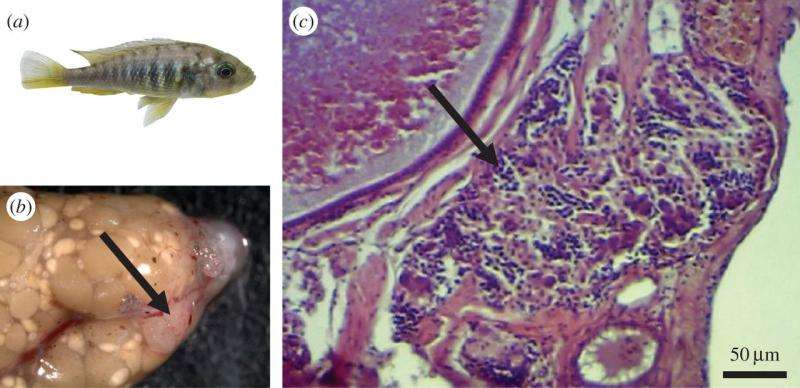March 24, 2016 report
Female fish develops male organs and impregnates self

(Phys.org)—A female cichlid hybrid fish has been observed to have grown male reproductive organs, impregnate itself and then to have offspring, a team of researchers in the U.K. are reporting in a paper published in the journal Royal Society Open Science. They call the process 'selfing' and suggest it is very rare in vertebrates.
The team reports that they were studying chichlid fish and at one point bred two different species of the fish, resulting in the birth of several offspring, only one of which later developed male reproductive organs. Such fish, they note reproduce by mixing sperm and egg sin the mouth. In this instance, it appeared that the hybrid ejected sperm into the water and then sucked it into its mouth where it fertilized the eggs that were waiting there. The fish shortly thereafter gave birth to several offspring. Also, the team reports, it was not a onetime occurrence, the fish self fertilized itself many times over the course of a year, giving birth to 42 offspring (both male and female) of which it was both the mother and father. The offspring all appeared normal and reproduced without any of them resorting to selfing. They did all suffer, however, from what scientists call inbreeding depression, where there is minimal genetic diversity, which can lead to birth defects in subsequent generations. Having two genders it is believed was an evolutionary development that came about to allow for genetic diversity, after all.
Selfing is not unheard of in the animal kingdom, other species such as mangrove killifish engage in it as part of their normal reproductive habits—but in their case, it is one born of necessity when there are no potential mates around—it is also an adaption that came about out of necessity. The researchers believe the selfing observed in the cichlid female likely came about due to its parents having different sex-determining genes, and that it was almost certainly an oddity, and thus not likely to happen again anytime soon. They note also that it is not likely that this was the first occurrence of selfig in the species, such instances have likely gone underreported due to its rarity.
More information: Ola Svensson et al. Hybridization generates a hopeful monster: a hermaphroditic selfing cichlid, Royal Society Open Science (2016). DOI: 10.1098/rsos.150684
Abstract
Compared with other phylogenetic groups, self-fertilization (selfing) is exceedingly rare in vertebrates and is known to occur only in one small clade of fishes. Here we report observing one F1-hybrid individual that developed into a functional hermaphrodite after crossing two closely-related sexually reproducing species of cichlids. Microsatellite alleles segregated consistent with selfing and Mendelian inheritance and we could rule out different modes of parthenogenesis including automixis. We discuss why selfing is not more commonly observed in vertebrates in nature, and the role of hybridization in the evolution of novel traits.
Journal information: Royal Society Open Science
© 2016 Phys.org



















